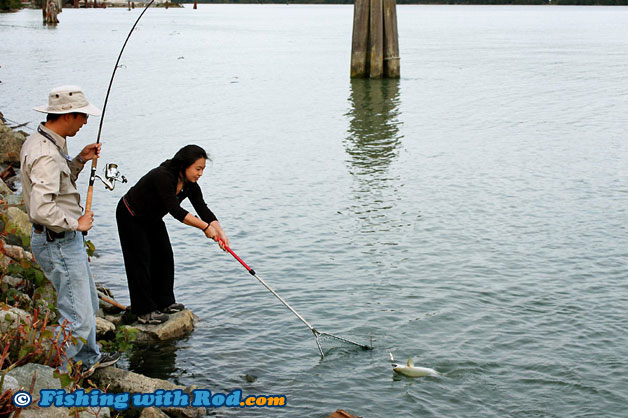Dyke Road (between No. 4 & 5 Road), Richmond
By Rodney Hsu

Most of the shorelines along Richmond can easily be accessed because of the scenic roads along them. Dyke Road between the southern end of No. 4 and 5 Roads takes you to several peaceful fishing spots along the South Arm of the Fraser River. This may surprise many anglers due to the fact that they do not have to leave the city for this type of fishing experience. Unlike Dyke Road between No. 2 and 3 Roads, the outgoing tide current does not seem as strong so fishing with light tackle is not as challenging. Beside year-round white sturgeon fishing, salmon, trout and numerous coarse fish species are seasonally abundant.
How to Get There?
To access Dyke Road, simply drive southbound on No. 5 Road until you reach the end. The road turns right at the end, which becomes Dyke Road. Parking is plentiful and unlike other roads along Richmond's shorelines, traffic is generally light.
Fishing Season
White sturgeon fishing can be done year-round along Dyke Road, especially in the wooded area near the eastern opening of Finn Slough. Please remember that this is a catch and release fishery, all white sturgeon are required to be released.
Between May and September, coarse fish such as peamouth chub and northern pikeminnow are highly abundant during flood tides.
In March and April, coastal cutthroat trout and bull trout usually emerge when juvenile salmon begin migrating downstream on the Fraser River. Their feeding activities can be seen very close to shore when they feed aggressively on the surface.
During odd years, the pink salmon fishery is extremely productive in September. When they enter the Fraser River during each incoming tide, dozens of anglers in all age groups can be seen along this road. Although it is possible to also catch coho and chum salmon in October and November, they tend to travel through this stretch rather quickly so the chance of connecting with one is slim.
Fishing Techniques
Fishing can be done from the rocks along Dyke Road, but one should always watch the tide line and waves. During low tides, the exposed rocks can be rather slippery to stand on. Large waves occur from time to time when tug boats and cargo ships pass by.
Fishing is best during the period between two hours before and after the flood tide. Current is the weakest during this time. To target coarse fish in the summer, a simple bottom rig that anchors the bait on the bottom works best. Make sure enough weight is used so it does not drift in the current.
When the tide peaks, there are often little bays formed. These bays lack the current produced in the main channel of South Arm, so bait fishing under a float is possible.
To target trout and char, use a light spincasting outfit and entice them with small spoons, spinners, jigs or crankbaits. These predatory species would grab any moving lure whenever opportunities are presented in front of them. The large pylons and other rocky structures are great places where these fish may hide. This is a catch and release fishery (with the exception of hatchery trout retention) so carry a net for proper fish handling if possible.
In the fall salmon season, casting spoons and spinners during the incoming tide may result in some surprising catches at times. Water clarity is often the biggest factor that dictates your salmon fishing success in this area. When permitted, you can also target chinook, coho and chum salmon by bottom fishing with freshly cured roe.
Because white sturgeon in the Fraser River can be up to six feet or even larger, anglers should choose to use tackle that is heavy enough to handle these specimen. You may need a longer rod when shore fishing for white sturgeon to avoid snags that are close to shore. A variety of bait such as eulachon and roe are productive, depending on the time of the year. Choose your bait according to the natural food source that is available at the time.
Important Notes
Before your first fishing trip to Dyke Road, please make sure you know the following information:
- You must have a valid British Columbia tidal fishing licence.
- Richmond is located in Fisheries and Oceans Canada's Area 29. Please read the general tidal fishing regulations and Area 29's regulations. The salmon fishing openings are usually announced during the season, so it is always best to check for opening times and other restrictions before heading out.
- There is often a bait ban for salmon fishing in September and part of October, so please be sure to check before you choose to use bait. Your local tackle stores will have the latest information.
- Please respect other users, local residents and wildlife by keeping this area clean.

